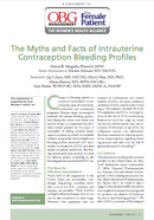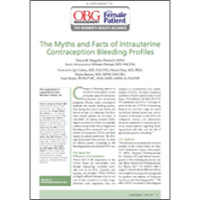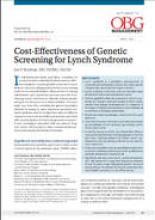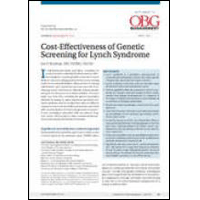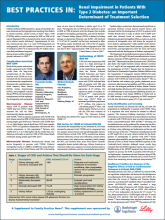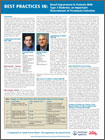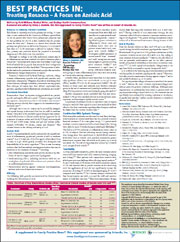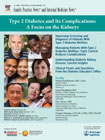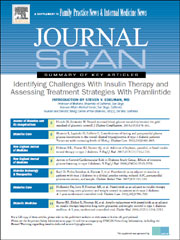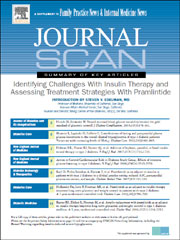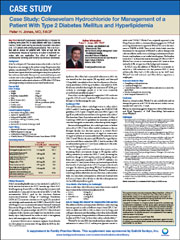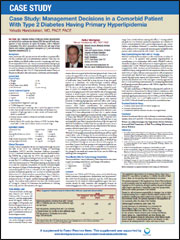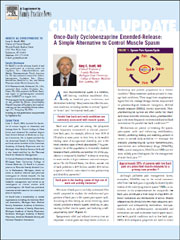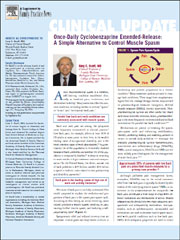User login
The Myths and Facts of Intrauterine Contraception Bleeding Profiles
10 practical, evidence-based suggestions to improve your minimally invasive surgical skills now
- Update on minimally invasive surgery
Amy Garcia (April 2011) - Applying single-incision laparoscopic surgery to gyn practice: What’s involved
Russell P. Atkin, MD; Michael L. Nimaroff, MD; Vrunda Bhavsar, MD (April 2011)
When my colleague, Dr. Mark D. Walters, offered “10 practical, evidence-based suggestions to improve your gyn practice now” in the January 2011 issue of OBG Management [available at www.obgmanagement.com], he made an important observation: “Attention to evidence-based guidelines and to outcomes for individual patients continues to drive medicine…you’re challenged to sort through the great, and growing, mass of medical information so you can focus on key issues that improve care.”
Dr. Walters’ succinct, invaluable suggestions for your gyn practice launched what will be a recurring format, on a range of topics in women’s health care, in the pages of this publication.
So in this article is, once again, capsule advice for you: this time, my 10 suggestions for performing minimally invasive gyn surgery—including two when you use the robot. These pearls are backed by evidence and easy to put into practice. And, again, each includes a pertinent reference from the literature.
1. Entry: Be safe
Use Palmer’s point in the left upper-abdominal quadrant for laparoscopic entry in patients who have had any prior abdominal surgery.
Granata M, Tsimpanakos I, Moeity F, Magos A. Are we underutilizing Palmer’s point entry in gynecologic laparoscopy? Fertil Steril. 2010;94(7):2716–2719.
Laparoscopic entry in the left-upper quadrant is safe and is associated with a low rate of failure. Gyn surgeons tend to underutilize this route of entry; using it can significantly reduce the rate of bowel injury that can occur with attempted umbilical entry.*
*A video that describes the appropriate anatomy is found at www.academyofpelvicsurgery.com (Module 5, Video 3 in the “Video Library”).
2. Port sites—come in high
Place accessory ports 1) under direct vision and 2) above the anterior superior iliac spine, to avoid injury to the ilioinguinal and iliohypogastric nerves.
Whiteside JL, Barber MD, Walters MD, Falcone T. Anatomy of ilioinguinal and iliohypogastric nerves in relation to trocar placement and low transverse incisions. Am J Obstet Gynecol. 2003;189(6):1574–1578.
The right lower- and left lower-abdominal port sites that are used in laparoscopic pelvic surgery are common causes of these troubling complications.
3. Worry less about the Veress
The various Veress needle safety tests or checks provide little useful information about the placement of the needle. Furthermore, avoid wiggling the Veress needle: Such movement can enlarge a 1.6 mm puncture to an injury as large as 1 cm in viscera or blood vessels.
Vilos GA, Ternamian A, Dempster J, Laberge PY; the Society of Obstetricians and Gynecologists of Canada. Laparoscopic entry: a review of techniques, technologies, and complications. J Obstet Gynaecol Can. 2007;29(5):433–465.
Instead, an opening pressure of <10 mm Hg is a reliable indicator of correct intraperitoneal placement of a laparoscopic trocar.
4. Keep risk of herniation low
Hernias at the site of laparoscopic ports are significantly more common with 12-mm trocars—even bladeless, radially expanding ones. Close fascia, therefore, when you’ve used any type of trocar that is 10 mm or greater in diameter.
Chiong E, Hegarty PK, Davis JW, Kamat AM, Pisters LL, Matin SF. Port-site hernias occurring after the use of bladeless radially expanding trocars. Urology. 2010;75(3):574–580.
Patients who develop nausea or vomiting after laparoscopic surgery should have an early computed tomographic scan performed to evaluate them for port-site herniation or bowel injury, or both.
5. Arm tucking
Avoid brachial plexus injury in laparoscopic surgery by always tucking the arms, instead of placing them on arm boards that can inadvertently be moved beyond horizontal during the surgery.
Shveiky D, Aseff JN, Iglesia CB. Brachial plexus injury after laparoscopic and robotic surgery. J Minim Invasive Gynecol. 2010;17(4):414–420.
This routine safety measure takes little additional time and facilitates more comfortable access to the patient.
6. Release of gas
Completely evacuate all pneumoperitoneum and instruct the anesthesiologist to perform five manual inflations of the lungs before the patient is taken out of Trendelenburg position.
Phelps P, Cakmakkaya OS, Apfel CC, Radke OC. A simple clinical maneuver to reduce laparoscopy-induced shoulder pain: a randomized controlled trial. Obstet Gynecol. 2008;111(5):1155–1160.
These maneuvers help to avoid having a bubble of gas trapped under the diaphragm—an uncomfortable problem for many women after laparoscopic surgery.
If you are even remotely suspicious that a ureter has sustained thermal damage, recognize that immediate efflux of indigo carmine dye from the ureteric orifices does not predict delayed post-operative ureteral necrosis and a subsequent leak or fistula.
Parpala-Sparman T, Paananen I, Santala M, Ohtonen P, Hellstrom P. Increasing numbers of ureteric injuries after the introduction of laparoscopic surgery. Scand J Urol Nephrol. 2008;42(5):422–427.
Consult urology to place a ureteral stent for 6 weeks to ensure complete healing of the potential injury.
8. Vaginal cuff dehiscence
Recognize that vaginal bleeding and sudden watery discharge are the most common presenting symptoms of vaginal cuff dehiscence after hysterectomy.
Kho RM, Akl MN, Cornella JL, Magtibay PM, Wechter ME, Magrina JF. Incidence and characteristics of patients with vaginal cuff dehiscence after robotic procedures. Obstet Gynecol. 2009;114(2 pt 1):231–235.
With a mean time to presentation postoperatively of approximately 6 weeks, vaginal cuff dehiscence occurs at a higher rate after laparoscopic and robotic hysterectomy (with the latter, reported to be as high as 4.1%) than it does after abdominal or vaginal hysterectomy, and is often triggered by coitus. Your efforts to reduce the risk of this complication should include 1) limited use of thermal energy when performing colpotomy and 2) paying attention to placing sutures into healthy vaginal tissue.
Place patients directly on egg-crate foam for robotic surgery. Doing so results in minimal movement on the table, even in the maximal Trendelenburg position.
Klauschie J, Wechter ME, Jacob K, et al. Use of anti-skid material and patient positioning to prevent patient shifting during robotic-assisted gynecologic procedures. J Minim Invasive Gynecol. 2010;17(4):504–507.
This tactic is economical and isn’t associated with any risk of brachial plexus injury—a complication that can occur with incorrect use of the shoulder blocks that are commonly used to prevent slipping.
Position robotic ports at least 10 cm apart to avoid interference by the robotic arm. You need a distance of at least 15 cm from the symphysis to the umbilicus to have adequate room between camera and pelvis.
Matthews CA, Schubert CM, Woodward AP, Gill EJ. Variance in abdominal wall anatomy and port placement in women undergoing robotic gynecologic surgery. J Minim Invasive Gynecol. 2010;17(5):583–586.
Because African-American women often have shorter lower-abdominal dimensions than white women, they sometimes require port placement above the umbilicus. Interference by the robotic arm will frustrate many novice robotic surgeons; this easy technique prevents these problem situations in most cases.
We want to hear from you! Tell us what you think.
- Update on minimally invasive surgery
Amy Garcia (April 2011) - Applying single-incision laparoscopic surgery to gyn practice: What’s involved
Russell P. Atkin, MD; Michael L. Nimaroff, MD; Vrunda Bhavsar, MD (April 2011)
When my colleague, Dr. Mark D. Walters, offered “10 practical, evidence-based suggestions to improve your gyn practice now” in the January 2011 issue of OBG Management [available at www.obgmanagement.com], he made an important observation: “Attention to evidence-based guidelines and to outcomes for individual patients continues to drive medicine…you’re challenged to sort through the great, and growing, mass of medical information so you can focus on key issues that improve care.”
Dr. Walters’ succinct, invaluable suggestions for your gyn practice launched what will be a recurring format, on a range of topics in women’s health care, in the pages of this publication.
So in this article is, once again, capsule advice for you: this time, my 10 suggestions for performing minimally invasive gyn surgery—including two when you use the robot. These pearls are backed by evidence and easy to put into practice. And, again, each includes a pertinent reference from the literature.
1. Entry: Be safe
Use Palmer’s point in the left upper-abdominal quadrant for laparoscopic entry in patients who have had any prior abdominal surgery.
Granata M, Tsimpanakos I, Moeity F, Magos A. Are we underutilizing Palmer’s point entry in gynecologic laparoscopy? Fertil Steril. 2010;94(7):2716–2719.
Laparoscopic entry in the left-upper quadrant is safe and is associated with a low rate of failure. Gyn surgeons tend to underutilize this route of entry; using it can significantly reduce the rate of bowel injury that can occur with attempted umbilical entry.*
*A video that describes the appropriate anatomy is found at www.academyofpelvicsurgery.com (Module 5, Video 3 in the “Video Library”).
2. Port sites—come in high
Place accessory ports 1) under direct vision and 2) above the anterior superior iliac spine, to avoid injury to the ilioinguinal and iliohypogastric nerves.
Whiteside JL, Barber MD, Walters MD, Falcone T. Anatomy of ilioinguinal and iliohypogastric nerves in relation to trocar placement and low transverse incisions. Am J Obstet Gynecol. 2003;189(6):1574–1578.
The right lower- and left lower-abdominal port sites that are used in laparoscopic pelvic surgery are common causes of these troubling complications.
3. Worry less about the Veress
The various Veress needle safety tests or checks provide little useful information about the placement of the needle. Furthermore, avoid wiggling the Veress needle: Such movement can enlarge a 1.6 mm puncture to an injury as large as 1 cm in viscera or blood vessels.
Vilos GA, Ternamian A, Dempster J, Laberge PY; the Society of Obstetricians and Gynecologists of Canada. Laparoscopic entry: a review of techniques, technologies, and complications. J Obstet Gynaecol Can. 2007;29(5):433–465.
Instead, an opening pressure of <10 mm Hg is a reliable indicator of correct intraperitoneal placement of a laparoscopic trocar.
4. Keep risk of herniation low
Hernias at the site of laparoscopic ports are significantly more common with 12-mm trocars—even bladeless, radially expanding ones. Close fascia, therefore, when you’ve used any type of trocar that is 10 mm or greater in diameter.
Chiong E, Hegarty PK, Davis JW, Kamat AM, Pisters LL, Matin SF. Port-site hernias occurring after the use of bladeless radially expanding trocars. Urology. 2010;75(3):574–580.
Patients who develop nausea or vomiting after laparoscopic surgery should have an early computed tomographic scan performed to evaluate them for port-site herniation or bowel injury, or both.
5. Arm tucking
Avoid brachial plexus injury in laparoscopic surgery by always tucking the arms, instead of placing them on arm boards that can inadvertently be moved beyond horizontal during the surgery.
Shveiky D, Aseff JN, Iglesia CB. Brachial plexus injury after laparoscopic and robotic surgery. J Minim Invasive Gynecol. 2010;17(4):414–420.
This routine safety measure takes little additional time and facilitates more comfortable access to the patient.
6. Release of gas
Completely evacuate all pneumoperitoneum and instruct the anesthesiologist to perform five manual inflations of the lungs before the patient is taken out of Trendelenburg position.
Phelps P, Cakmakkaya OS, Apfel CC, Radke OC. A simple clinical maneuver to reduce laparoscopy-induced shoulder pain: a randomized controlled trial. Obstet Gynecol. 2008;111(5):1155–1160.
These maneuvers help to avoid having a bubble of gas trapped under the diaphragm—an uncomfortable problem for many women after laparoscopic surgery.
If you are even remotely suspicious that a ureter has sustained thermal damage, recognize that immediate efflux of indigo carmine dye from the ureteric orifices does not predict delayed post-operative ureteral necrosis and a subsequent leak or fistula.
Parpala-Sparman T, Paananen I, Santala M, Ohtonen P, Hellstrom P. Increasing numbers of ureteric injuries after the introduction of laparoscopic surgery. Scand J Urol Nephrol. 2008;42(5):422–427.
Consult urology to place a ureteral stent for 6 weeks to ensure complete healing of the potential injury.
8. Vaginal cuff dehiscence
Recognize that vaginal bleeding and sudden watery discharge are the most common presenting symptoms of vaginal cuff dehiscence after hysterectomy.
Kho RM, Akl MN, Cornella JL, Magtibay PM, Wechter ME, Magrina JF. Incidence and characteristics of patients with vaginal cuff dehiscence after robotic procedures. Obstet Gynecol. 2009;114(2 pt 1):231–235.
With a mean time to presentation postoperatively of approximately 6 weeks, vaginal cuff dehiscence occurs at a higher rate after laparoscopic and robotic hysterectomy (with the latter, reported to be as high as 4.1%) than it does after abdominal or vaginal hysterectomy, and is often triggered by coitus. Your efforts to reduce the risk of this complication should include 1) limited use of thermal energy when performing colpotomy and 2) paying attention to placing sutures into healthy vaginal tissue.
Place patients directly on egg-crate foam for robotic surgery. Doing so results in minimal movement on the table, even in the maximal Trendelenburg position.
Klauschie J, Wechter ME, Jacob K, et al. Use of anti-skid material and patient positioning to prevent patient shifting during robotic-assisted gynecologic procedures. J Minim Invasive Gynecol. 2010;17(4):504–507.
This tactic is economical and isn’t associated with any risk of brachial plexus injury—a complication that can occur with incorrect use of the shoulder blocks that are commonly used to prevent slipping.
Position robotic ports at least 10 cm apart to avoid interference by the robotic arm. You need a distance of at least 15 cm from the symphysis to the umbilicus to have adequate room between camera and pelvis.
Matthews CA, Schubert CM, Woodward AP, Gill EJ. Variance in abdominal wall anatomy and port placement in women undergoing robotic gynecologic surgery. J Minim Invasive Gynecol. 2010;17(5):583–586.
Because African-American women often have shorter lower-abdominal dimensions than white women, they sometimes require port placement above the umbilicus. Interference by the robotic arm will frustrate many novice robotic surgeons; this easy technique prevents these problem situations in most cases.
We want to hear from you! Tell us what you think.
- Update on minimally invasive surgery
Amy Garcia (April 2011) - Applying single-incision laparoscopic surgery to gyn practice: What’s involved
Russell P. Atkin, MD; Michael L. Nimaroff, MD; Vrunda Bhavsar, MD (April 2011)
When my colleague, Dr. Mark D. Walters, offered “10 practical, evidence-based suggestions to improve your gyn practice now” in the January 2011 issue of OBG Management [available at www.obgmanagement.com], he made an important observation: “Attention to evidence-based guidelines and to outcomes for individual patients continues to drive medicine…you’re challenged to sort through the great, and growing, mass of medical information so you can focus on key issues that improve care.”
Dr. Walters’ succinct, invaluable suggestions for your gyn practice launched what will be a recurring format, on a range of topics in women’s health care, in the pages of this publication.
So in this article is, once again, capsule advice for you: this time, my 10 suggestions for performing minimally invasive gyn surgery—including two when you use the robot. These pearls are backed by evidence and easy to put into practice. And, again, each includes a pertinent reference from the literature.
1. Entry: Be safe
Use Palmer’s point in the left upper-abdominal quadrant for laparoscopic entry in patients who have had any prior abdominal surgery.
Granata M, Tsimpanakos I, Moeity F, Magos A. Are we underutilizing Palmer’s point entry in gynecologic laparoscopy? Fertil Steril. 2010;94(7):2716–2719.
Laparoscopic entry in the left-upper quadrant is safe and is associated with a low rate of failure. Gyn surgeons tend to underutilize this route of entry; using it can significantly reduce the rate of bowel injury that can occur with attempted umbilical entry.*
*A video that describes the appropriate anatomy is found at www.academyofpelvicsurgery.com (Module 5, Video 3 in the “Video Library”).
2. Port sites—come in high
Place accessory ports 1) under direct vision and 2) above the anterior superior iliac spine, to avoid injury to the ilioinguinal and iliohypogastric nerves.
Whiteside JL, Barber MD, Walters MD, Falcone T. Anatomy of ilioinguinal and iliohypogastric nerves in relation to trocar placement and low transverse incisions. Am J Obstet Gynecol. 2003;189(6):1574–1578.
The right lower- and left lower-abdominal port sites that are used in laparoscopic pelvic surgery are common causes of these troubling complications.
3. Worry less about the Veress
The various Veress needle safety tests or checks provide little useful information about the placement of the needle. Furthermore, avoid wiggling the Veress needle: Such movement can enlarge a 1.6 mm puncture to an injury as large as 1 cm in viscera or blood vessels.
Vilos GA, Ternamian A, Dempster J, Laberge PY; the Society of Obstetricians and Gynecologists of Canada. Laparoscopic entry: a review of techniques, technologies, and complications. J Obstet Gynaecol Can. 2007;29(5):433–465.
Instead, an opening pressure of <10 mm Hg is a reliable indicator of correct intraperitoneal placement of a laparoscopic trocar.
4. Keep risk of herniation low
Hernias at the site of laparoscopic ports are significantly more common with 12-mm trocars—even bladeless, radially expanding ones. Close fascia, therefore, when you’ve used any type of trocar that is 10 mm or greater in diameter.
Chiong E, Hegarty PK, Davis JW, Kamat AM, Pisters LL, Matin SF. Port-site hernias occurring after the use of bladeless radially expanding trocars. Urology. 2010;75(3):574–580.
Patients who develop nausea or vomiting after laparoscopic surgery should have an early computed tomographic scan performed to evaluate them for port-site herniation or bowel injury, or both.
5. Arm tucking
Avoid brachial plexus injury in laparoscopic surgery by always tucking the arms, instead of placing them on arm boards that can inadvertently be moved beyond horizontal during the surgery.
Shveiky D, Aseff JN, Iglesia CB. Brachial plexus injury after laparoscopic and robotic surgery. J Minim Invasive Gynecol. 2010;17(4):414–420.
This routine safety measure takes little additional time and facilitates more comfortable access to the patient.
6. Release of gas
Completely evacuate all pneumoperitoneum and instruct the anesthesiologist to perform five manual inflations of the lungs before the patient is taken out of Trendelenburg position.
Phelps P, Cakmakkaya OS, Apfel CC, Radke OC. A simple clinical maneuver to reduce laparoscopy-induced shoulder pain: a randomized controlled trial. Obstet Gynecol. 2008;111(5):1155–1160.
These maneuvers help to avoid having a bubble of gas trapped under the diaphragm—an uncomfortable problem for many women after laparoscopic surgery.
If you are even remotely suspicious that a ureter has sustained thermal damage, recognize that immediate efflux of indigo carmine dye from the ureteric orifices does not predict delayed post-operative ureteral necrosis and a subsequent leak or fistula.
Parpala-Sparman T, Paananen I, Santala M, Ohtonen P, Hellstrom P. Increasing numbers of ureteric injuries after the introduction of laparoscopic surgery. Scand J Urol Nephrol. 2008;42(5):422–427.
Consult urology to place a ureteral stent for 6 weeks to ensure complete healing of the potential injury.
8. Vaginal cuff dehiscence
Recognize that vaginal bleeding and sudden watery discharge are the most common presenting symptoms of vaginal cuff dehiscence after hysterectomy.
Kho RM, Akl MN, Cornella JL, Magtibay PM, Wechter ME, Magrina JF. Incidence and characteristics of patients with vaginal cuff dehiscence after robotic procedures. Obstet Gynecol. 2009;114(2 pt 1):231–235.
With a mean time to presentation postoperatively of approximately 6 weeks, vaginal cuff dehiscence occurs at a higher rate after laparoscopic and robotic hysterectomy (with the latter, reported to be as high as 4.1%) than it does after abdominal or vaginal hysterectomy, and is often triggered by coitus. Your efforts to reduce the risk of this complication should include 1) limited use of thermal energy when performing colpotomy and 2) paying attention to placing sutures into healthy vaginal tissue.
Place patients directly on egg-crate foam for robotic surgery. Doing so results in minimal movement on the table, even in the maximal Trendelenburg position.
Klauschie J, Wechter ME, Jacob K, et al. Use of anti-skid material and patient positioning to prevent patient shifting during robotic-assisted gynecologic procedures. J Minim Invasive Gynecol. 2010;17(4):504–507.
This tactic is economical and isn’t associated with any risk of brachial plexus injury—a complication that can occur with incorrect use of the shoulder blocks that are commonly used to prevent slipping.
Position robotic ports at least 10 cm apart to avoid interference by the robotic arm. You need a distance of at least 15 cm from the symphysis to the umbilicus to have adequate room between camera and pelvis.
Matthews CA, Schubert CM, Woodward AP, Gill EJ. Variance in abdominal wall anatomy and port placement in women undergoing robotic gynecologic surgery. J Minim Invasive Gynecol. 2010;17(5):583–586.
Because African-American women often have shorter lower-abdominal dimensions than white women, they sometimes require port placement above the umbilicus. Interference by the robotic arm will frustrate many novice robotic surgeons; this easy technique prevents these problem situations in most cases.
We want to hear from you! Tell us what you think.
Cost-Effectiveness of Genetic Screening for Lynch Syndrome
BEST PRACTICES IN: Renal Impairment in Patients With Type 2 Diabetes: an Important Determinant of Treatment Selection
A supplement to Family Practice News®. This supplement was sponsored by Boehringer Ingelheim Pharmaceuticals, Inc. and Eli Lilly and Company.
To view the supplement, click the image above.
Topics
- Complications Associated With T2DM
- Epidemiology of CKD/RI With DM
- Risk Factors for CKD/RI in Patients With DM
- Early Identification and Screening
- Healthcare Providers Are Unaware of the Negative Effects of CKD on Cardiovascular Outcomes in Patients With T2DM
- Awareness of CKD/RI: Clinicians
- Awareness of CKD/RI: Patients
- Awareness of CKD/RI: Glycemic Control
- Prevention and Management
Faculty/Faculty Disclosure
Fernando Ovalle, MD
Associate Professor, Medicine
Director, Fellowship Training Program,
Diabetes & Endocrine Research Unit and Comprehensive Diabetes Clinic
UAB School of Medicine
Birmingham, AL
Michael Kodack, PharmD
Vice President, Medical
BlueSpark Healthcare Communications LLC
Basking Ridge, NJ
Fernando Ovalle, MD, has disclosed no potential conflicts of interest. Michael Kodack, PharmD, is an employee of BlueSpark Healthcare Communications LLC.
Copyright © 2011 Elsevier Inc.
A supplement to Family Practice News®. This supplement was sponsored by Boehringer Ingelheim Pharmaceuticals, Inc. and Eli Lilly and Company.
To view the supplement, click the image above.
Topics
- Complications Associated With T2DM
- Epidemiology of CKD/RI With DM
- Risk Factors for CKD/RI in Patients With DM
- Early Identification and Screening
- Healthcare Providers Are Unaware of the Negative Effects of CKD on Cardiovascular Outcomes in Patients With T2DM
- Awareness of CKD/RI: Clinicians
- Awareness of CKD/RI: Patients
- Awareness of CKD/RI: Glycemic Control
- Prevention and Management
Faculty/Faculty Disclosure
Fernando Ovalle, MD
Associate Professor, Medicine
Director, Fellowship Training Program,
Diabetes & Endocrine Research Unit and Comprehensive Diabetes Clinic
UAB School of Medicine
Birmingham, AL
Michael Kodack, PharmD
Vice President, Medical
BlueSpark Healthcare Communications LLC
Basking Ridge, NJ
Fernando Ovalle, MD, has disclosed no potential conflicts of interest. Michael Kodack, PharmD, is an employee of BlueSpark Healthcare Communications LLC.
Copyright © 2011 Elsevier Inc.
A supplement to Family Practice News®. This supplement was sponsored by Boehringer Ingelheim Pharmaceuticals, Inc. and Eli Lilly and Company.
To view the supplement, click the image above.
Topics
- Complications Associated With T2DM
- Epidemiology of CKD/RI With DM
- Risk Factors for CKD/RI in Patients With DM
- Early Identification and Screening
- Healthcare Providers Are Unaware of the Negative Effects of CKD on Cardiovascular Outcomes in Patients With T2DM
- Awareness of CKD/RI: Clinicians
- Awareness of CKD/RI: Patients
- Awareness of CKD/RI: Glycemic Control
- Prevention and Management
Faculty/Faculty Disclosure
Fernando Ovalle, MD
Associate Professor, Medicine
Director, Fellowship Training Program,
Diabetes & Endocrine Research Unit and Comprehensive Diabetes Clinic
UAB School of Medicine
Birmingham, AL
Michael Kodack, PharmD
Vice President, Medical
BlueSpark Healthcare Communications LLC
Basking Ridge, NJ
Fernando Ovalle, MD, has disclosed no potential conflicts of interest. Michael Kodack, PharmD, is an employee of BlueSpark Healthcare Communications LLC.
Copyright © 2011 Elsevier Inc.
BEST PRACTICES IN: Treating Rosacea - A Focus on Azelaic Acid
A supplement to Family Practice News. This supplement was sponsored by Intendis, Inc.
Written by Ruth Williams, Medical Writer, and Medisys Health Communications, LLC, on behalf of Intendis, Inc.
•Topics
•Faculty/Faculty Disclosures
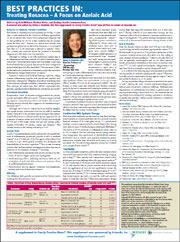
To view the supplement, click the image above.
Topics
• Rosacea: A Common, Chronic Condition
• Treatment Essentials
• Azelaic Acid
• Efficacy
• Combination With Systemic Therapy
• Tolerability
• AzA in Practice
Faculty/Faculty Disclosure
Hilary E. Baldwin, MD
Associate Professor of Dermatology
SUNY-Brooklyn
Brooklyn, New York
Dr Baldwin is a Consultant/Advisory Board/ Speakers' Bureau member of Allergan, Inc., Coria Laboratories Ltd, Galderma Laboratories, L.P., GlaxoSmithKline, Intendis, Inc., Medicis Pharmaceutical Corporation, OrthoNeutrogena, Ranbaxy Pharmaceuticals, sanofi-aventis, and Stiefel Laboratories.
Copyright © 2010 Elsevier Inc.
A supplement to Family Practice News. This supplement was sponsored by Intendis, Inc.
Written by Ruth Williams, Medical Writer, and Medisys Health Communications, LLC, on behalf of Intendis, Inc.
•Topics
•Faculty/Faculty Disclosures

To view the supplement, click the image above.
Topics
• Rosacea: A Common, Chronic Condition
• Treatment Essentials
• Azelaic Acid
• Efficacy
• Combination With Systemic Therapy
• Tolerability
• AzA in Practice
Faculty/Faculty Disclosure
Hilary E. Baldwin, MD
Associate Professor of Dermatology
SUNY-Brooklyn
Brooklyn, New York
Dr Baldwin is a Consultant/Advisory Board/ Speakers' Bureau member of Allergan, Inc., Coria Laboratories Ltd, Galderma Laboratories, L.P., GlaxoSmithKline, Intendis, Inc., Medicis Pharmaceutical Corporation, OrthoNeutrogena, Ranbaxy Pharmaceuticals, sanofi-aventis, and Stiefel Laboratories.
Copyright © 2010 Elsevier Inc.
A supplement to Family Practice News. This supplement was sponsored by Intendis, Inc.
Written by Ruth Williams, Medical Writer, and Medisys Health Communications, LLC, on behalf of Intendis, Inc.
•Topics
•Faculty/Faculty Disclosures

To view the supplement, click the image above.
Topics
• Rosacea: A Common, Chronic Condition
• Treatment Essentials
• Azelaic Acid
• Efficacy
• Combination With Systemic Therapy
• Tolerability
• AzA in Practice
Faculty/Faculty Disclosure
Hilary E. Baldwin, MD
Associate Professor of Dermatology
SUNY-Brooklyn
Brooklyn, New York
Dr Baldwin is a Consultant/Advisory Board/ Speakers' Bureau member of Allergan, Inc., Coria Laboratories Ltd, Galderma Laboratories, L.P., GlaxoSmithKline, Intendis, Inc., Medicis Pharmaceutical Corporation, OrthoNeutrogena, Ranbaxy Pharmaceuticals, sanofi-aventis, and Stiefel Laboratories.
Copyright © 2010 Elsevier Inc.
Type 2 Diabetes and Its Complications: A Focus on the Kidneys . . .
This activity was written from interviews with the faculty.
Click Here to view the supplement.
- Faculty
- Topic Highlights
- Target Audience
- Educational Needs
- Learning Objectives
- Disclosure
- Accreditation
Faculty
Yehuda Handelsman, MD–Chair
Medical Director
Metabolic Institute of America
Tarzana, CA
Stuart Shankland, MD
Belding H. Scribner Endowed Chair of Medicine
Head, Division of Nephrology
University of Washington School of Medicine
Seattle, WA
Dace Trence, MD
Assistant Professor of Medicine
Director, Diabetes Care Center
University of Washington School of Medicine
Seattle, WA
Virginia Valentine, NP
Clinical Nurse Specialist, Diabetes
CEO, Diabetes Network
Albuquerque, NM
Topic Highlights
- Improving Screening and Diagnosis of Patients With Type 2 Diabetes Mellitus
- Managing Patients With Type 2 Diabetes Mellitus: Tight Control Reduces Complications
- Understanding Diabetic Kidney Disease: Current Insights
- Clinical Pearls and Questions From the Diabetes Educator’s Office
Target Audience
This educational activity is designed for endocrinologists, primary care physicians, nurses, diabetes educators, and other clinicians who treat patients with type 2 diabetes mellitus.
Educational Needs
The burden of type 2 diabetes mellitus (T2DM), in terms of morbidity, mortality, complications, and economic burden, is high and is predicted to rise even further. According to estimates from the US Centers for Disease Control and Prevention (CDC), between 7% and 8% of the population has T2DM, but this is projected to increase to 30% of the population within the next 30 years. The greatest increases are estimated to occur in African Americans and Hispanics, and in women (regardless of race or ethnicity). In addition, although diabetes screening has long been recommended for individuals beginning at around 50 years of age, this is no longer the case. Given the changing—and already altered—demographics of T2DM, clinicians should be monitoring for the disease in all patients over 30 years of age. Both microvascular (retinopathy, neuropathy, and nephropathy) and macrovascular (cardiovascular diseases) complications are consequences of less-than-optimal control of several important clinical parameters in patients with existing T2DM. Therefore, it is crucial that health care providers focus not only on good control of serum glucose but also on blood pressure and lipids as well. This supplement is designed to provide needed updates in the identifi cation and treatment of patients with T2DM, in order to reduce complications and the societal/medical burden of this disease.
Learning Objectives
By reading and studying this educational supplement, participants should be able to:
- Describe the potential for increased morbidity and accelerated mortality of suboptimally managed T2DM.
- List the risk factors for T2DM and discuss the recommendations for the screening and diagnosis of this disease.
- Discuss methods for identifying patients who may be at high risk for microvascular complications and explain the particular testing and treatment needs of patients who are at risk for renal impairment or failure.
- Critically review and, as necessary, revise existing strategies for building a multidisciplinary, collaborative approach to enhance communication among colleagues, educate patients, and improve treatment, as well as to locate and use quality assessment tools and guidelines.
- Demonstrate improved expertise in the management of patients with T2DM pharmacologic selection and explain the safety and efficacy profiles of antihyperglycemic agents when they are used in combination and/or with insulin.
Disclosure
Dr Handelsman has received grant/research support from Daiichi Sankyo, GlaxoSmithKline, Novartis, Novo Nordisk Inc., Takeda, sanofi - aventis, Tolerx, and XOMA. He has also received honoraria for being a consultant and/or serving on the speakers bureau for AstraZeneca, Bristol-Myers Squibb Company, Daiichi Sankyo, Gilead, Genentech, GlaxoSmithKline, Merck, Novartis, Takeda, Thetys, Tolerx, and XOMA.
Dr Handelsman is on the editorial advisory board of Clinical Endocrinology News.
Dr Trence has been a shareholder of Medtronic and sanofi -aventis.
Dr Shankland has no relevant financial relationships with any commercial interests.
Ms Valentine has received honoraria for being a consultant and/or serving on the speakers bureau and/or being a member of an advisory board for Amylin, Abbott Diabetes Care, Asante Solutions Inc., Boehringer Ingelheim, Calibra, Cequr, Dexcom, Intuity Medical, Eli Lilly and Company, Medtronic, F. Hoffman-La Roche Ltd., Pamlab, Takeda, and Tandem Pumps.
CHSE committee members have no relevant fi nancial relationships with any commercial interests: Carolyn Burns, MD; Dedra DeBerry, MA; Joyce Dunagan, MA, MSLS; Linda H. Freeman, DNS, RN; Terri Gipson, MSL; Ruth Greenberg, PhD; Lucy Juett, MS; Irene Litvan, MD; Loretta Maldaner; Mike Mansfi eld, DMD; Ashlee Melendez, RN, BSN; Lisa J. Pfi tzer, MD; Robert Sexton, MD; Uldis Streips, PhD; Kathy M. Vincent, MD; Lori Wagner, MD; Stephen Wheeler, MD; and Sharon Whitmer, EdD. CHSE offi ce staff members Jim Creg, Kim Moore, and Joyce Korfhage have no relevant relationships with any commercial interests.
Shirley Jones, Sylvia Reitman, and Michelle Rizzo with the Global Academy for Medical Education and medical writer Joanne Still have no relevant relationships with any commercial interests.
CME Reviewer: Ann Moore, MSN, RNC, FAANP, Professor of Nursing, Vanderbilt University School of Nursing, Nashville, TN, has no relevant relationships with any commercial interests.
RESOLUTION OF CONFLICT OF INTEREST
The CHSE has implemented a process to resolve conflict of interest for each CME activity. In order to help ensure content objectivity, independence and fair balance and to ensure that the content is aligned with the interest of the public, CHSE has resolved the conflict by external content review.
Unapproved/Off-Label Use Disclosure
CHSE requires CME faculty to disclose to the participants:
- When products or procedures being discussed are off-label, unlabeled, experimental, and or investigational (not US Food and Drug Administration [FDA] approved); and
- Any limitations on the information that is presented, such as data that are preliminary or that represent ongoing research, interim analyses, and/or unsupported opinion.
Faculty may discuss information about pharmaceutical agents that are outside of FDA-approved labeling. This information is intended solely for CME and is not intended to promote off-label use of these medications. If you have questions, contact the medical affairs department of the manufacturer for the most recent prescribing information.
None of the authors discusses off-label uses of any FDA-approved drugs.
Accreditation
This activity has been planned and implemented in accordance with the Essential Areas and Policies of the Accreditation Council for Continuing Medical Education (ACCME) through the joint sponsorship of the University of Louisville School of Medicine Continuing Health Sciences Education (CHSE) and Global Academy for Medical Education, LLC, an Elsevier business. CHSE is accredited by the ACCME to provide continuing education for physicians.
CHSE designates this educational activity for a maximum of 2.0 AMA PRA Category 1 Credit(s)TM. Physicians should only claim credit commensurate with the extent of their participation in the activity.
Term of Approval: February 1, 2011 – February 28, 2013.
Copyright (c) 2011 by Elsevier Inc.
This activity was written from interviews with the faculty.
Click Here to view the supplement.
- Faculty
- Topic Highlights
- Target Audience
- Educational Needs
- Learning Objectives
- Disclosure
- Accreditation
Faculty
Yehuda Handelsman, MD–Chair
Medical Director
Metabolic Institute of America
Tarzana, CA
Stuart Shankland, MD
Belding H. Scribner Endowed Chair of Medicine
Head, Division of Nephrology
University of Washington School of Medicine
Seattle, WA
Dace Trence, MD
Assistant Professor of Medicine
Director, Diabetes Care Center
University of Washington School of Medicine
Seattle, WA
Virginia Valentine, NP
Clinical Nurse Specialist, Diabetes
CEO, Diabetes Network
Albuquerque, NM
Topic Highlights
- Improving Screening and Diagnosis of Patients With Type 2 Diabetes Mellitus
- Managing Patients With Type 2 Diabetes Mellitus: Tight Control Reduces Complications
- Understanding Diabetic Kidney Disease: Current Insights
- Clinical Pearls and Questions From the Diabetes Educator’s Office
Target Audience
This educational activity is designed for endocrinologists, primary care physicians, nurses, diabetes educators, and other clinicians who treat patients with type 2 diabetes mellitus.
Educational Needs
The burden of type 2 diabetes mellitus (T2DM), in terms of morbidity, mortality, complications, and economic burden, is high and is predicted to rise even further. According to estimates from the US Centers for Disease Control and Prevention (CDC), between 7% and 8% of the population has T2DM, but this is projected to increase to 30% of the population within the next 30 years. The greatest increases are estimated to occur in African Americans and Hispanics, and in women (regardless of race or ethnicity). In addition, although diabetes screening has long been recommended for individuals beginning at around 50 years of age, this is no longer the case. Given the changing—and already altered—demographics of T2DM, clinicians should be monitoring for the disease in all patients over 30 years of age. Both microvascular (retinopathy, neuropathy, and nephropathy) and macrovascular (cardiovascular diseases) complications are consequences of less-than-optimal control of several important clinical parameters in patients with existing T2DM. Therefore, it is crucial that health care providers focus not only on good control of serum glucose but also on blood pressure and lipids as well. This supplement is designed to provide needed updates in the identifi cation and treatment of patients with T2DM, in order to reduce complications and the societal/medical burden of this disease.
Learning Objectives
By reading and studying this educational supplement, participants should be able to:
- Describe the potential for increased morbidity and accelerated mortality of suboptimally managed T2DM.
- List the risk factors for T2DM and discuss the recommendations for the screening and diagnosis of this disease.
- Discuss methods for identifying patients who may be at high risk for microvascular complications and explain the particular testing and treatment needs of patients who are at risk for renal impairment or failure.
- Critically review and, as necessary, revise existing strategies for building a multidisciplinary, collaborative approach to enhance communication among colleagues, educate patients, and improve treatment, as well as to locate and use quality assessment tools and guidelines.
- Demonstrate improved expertise in the management of patients with T2DM pharmacologic selection and explain the safety and efficacy profiles of antihyperglycemic agents when they are used in combination and/or with insulin.
Disclosure
Dr Handelsman has received grant/research support from Daiichi Sankyo, GlaxoSmithKline, Novartis, Novo Nordisk Inc., Takeda, sanofi - aventis, Tolerx, and XOMA. He has also received honoraria for being a consultant and/or serving on the speakers bureau for AstraZeneca, Bristol-Myers Squibb Company, Daiichi Sankyo, Gilead, Genentech, GlaxoSmithKline, Merck, Novartis, Takeda, Thetys, Tolerx, and XOMA.
Dr Handelsman is on the editorial advisory board of Clinical Endocrinology News.
Dr Trence has been a shareholder of Medtronic and sanofi -aventis.
Dr Shankland has no relevant financial relationships with any commercial interests.
Ms Valentine has received honoraria for being a consultant and/or serving on the speakers bureau and/or being a member of an advisory board for Amylin, Abbott Diabetes Care, Asante Solutions Inc., Boehringer Ingelheim, Calibra, Cequr, Dexcom, Intuity Medical, Eli Lilly and Company, Medtronic, F. Hoffman-La Roche Ltd., Pamlab, Takeda, and Tandem Pumps.
CHSE committee members have no relevant fi nancial relationships with any commercial interests: Carolyn Burns, MD; Dedra DeBerry, MA; Joyce Dunagan, MA, MSLS; Linda H. Freeman, DNS, RN; Terri Gipson, MSL; Ruth Greenberg, PhD; Lucy Juett, MS; Irene Litvan, MD; Loretta Maldaner; Mike Mansfi eld, DMD; Ashlee Melendez, RN, BSN; Lisa J. Pfi tzer, MD; Robert Sexton, MD; Uldis Streips, PhD; Kathy M. Vincent, MD; Lori Wagner, MD; Stephen Wheeler, MD; and Sharon Whitmer, EdD. CHSE offi ce staff members Jim Creg, Kim Moore, and Joyce Korfhage have no relevant relationships with any commercial interests.
Shirley Jones, Sylvia Reitman, and Michelle Rizzo with the Global Academy for Medical Education and medical writer Joanne Still have no relevant relationships with any commercial interests.
CME Reviewer: Ann Moore, MSN, RNC, FAANP, Professor of Nursing, Vanderbilt University School of Nursing, Nashville, TN, has no relevant relationships with any commercial interests.
RESOLUTION OF CONFLICT OF INTEREST
The CHSE has implemented a process to resolve conflict of interest for each CME activity. In order to help ensure content objectivity, independence and fair balance and to ensure that the content is aligned with the interest of the public, CHSE has resolved the conflict by external content review.
Unapproved/Off-Label Use Disclosure
CHSE requires CME faculty to disclose to the participants:
- When products or procedures being discussed are off-label, unlabeled, experimental, and or investigational (not US Food and Drug Administration [FDA] approved); and
- Any limitations on the information that is presented, such as data that are preliminary or that represent ongoing research, interim analyses, and/or unsupported opinion.
Faculty may discuss information about pharmaceutical agents that are outside of FDA-approved labeling. This information is intended solely for CME and is not intended to promote off-label use of these medications. If you have questions, contact the medical affairs department of the manufacturer for the most recent prescribing information.
None of the authors discusses off-label uses of any FDA-approved drugs.
Accreditation
This activity has been planned and implemented in accordance with the Essential Areas and Policies of the Accreditation Council for Continuing Medical Education (ACCME) through the joint sponsorship of the University of Louisville School of Medicine Continuing Health Sciences Education (CHSE) and Global Academy for Medical Education, LLC, an Elsevier business. CHSE is accredited by the ACCME to provide continuing education for physicians.
CHSE designates this educational activity for a maximum of 2.0 AMA PRA Category 1 Credit(s)TM. Physicians should only claim credit commensurate with the extent of their participation in the activity.
Term of Approval: February 1, 2011 – February 28, 2013.
Copyright (c) 2011 by Elsevier Inc.
This activity was written from interviews with the faculty.
Click Here to view the supplement.
- Faculty
- Topic Highlights
- Target Audience
- Educational Needs
- Learning Objectives
- Disclosure
- Accreditation
Faculty
Yehuda Handelsman, MD–Chair
Medical Director
Metabolic Institute of America
Tarzana, CA
Stuart Shankland, MD
Belding H. Scribner Endowed Chair of Medicine
Head, Division of Nephrology
University of Washington School of Medicine
Seattle, WA
Dace Trence, MD
Assistant Professor of Medicine
Director, Diabetes Care Center
University of Washington School of Medicine
Seattle, WA
Virginia Valentine, NP
Clinical Nurse Specialist, Diabetes
CEO, Diabetes Network
Albuquerque, NM
Topic Highlights
- Improving Screening and Diagnosis of Patients With Type 2 Diabetes Mellitus
- Managing Patients With Type 2 Diabetes Mellitus: Tight Control Reduces Complications
- Understanding Diabetic Kidney Disease: Current Insights
- Clinical Pearls and Questions From the Diabetes Educator’s Office
Target Audience
This educational activity is designed for endocrinologists, primary care physicians, nurses, diabetes educators, and other clinicians who treat patients with type 2 diabetes mellitus.
Educational Needs
The burden of type 2 diabetes mellitus (T2DM), in terms of morbidity, mortality, complications, and economic burden, is high and is predicted to rise even further. According to estimates from the US Centers for Disease Control and Prevention (CDC), between 7% and 8% of the population has T2DM, but this is projected to increase to 30% of the population within the next 30 years. The greatest increases are estimated to occur in African Americans and Hispanics, and in women (regardless of race or ethnicity). In addition, although diabetes screening has long been recommended for individuals beginning at around 50 years of age, this is no longer the case. Given the changing—and already altered—demographics of T2DM, clinicians should be monitoring for the disease in all patients over 30 years of age. Both microvascular (retinopathy, neuropathy, and nephropathy) and macrovascular (cardiovascular diseases) complications are consequences of less-than-optimal control of several important clinical parameters in patients with existing T2DM. Therefore, it is crucial that health care providers focus not only on good control of serum glucose but also on blood pressure and lipids as well. This supplement is designed to provide needed updates in the identifi cation and treatment of patients with T2DM, in order to reduce complications and the societal/medical burden of this disease.
Learning Objectives
By reading and studying this educational supplement, participants should be able to:
- Describe the potential for increased morbidity and accelerated mortality of suboptimally managed T2DM.
- List the risk factors for T2DM and discuss the recommendations for the screening and diagnosis of this disease.
- Discuss methods for identifying patients who may be at high risk for microvascular complications and explain the particular testing and treatment needs of patients who are at risk for renal impairment or failure.
- Critically review and, as necessary, revise existing strategies for building a multidisciplinary, collaborative approach to enhance communication among colleagues, educate patients, and improve treatment, as well as to locate and use quality assessment tools and guidelines.
- Demonstrate improved expertise in the management of patients with T2DM pharmacologic selection and explain the safety and efficacy profiles of antihyperglycemic agents when they are used in combination and/or with insulin.
Disclosure
Dr Handelsman has received grant/research support from Daiichi Sankyo, GlaxoSmithKline, Novartis, Novo Nordisk Inc., Takeda, sanofi - aventis, Tolerx, and XOMA. He has also received honoraria for being a consultant and/or serving on the speakers bureau for AstraZeneca, Bristol-Myers Squibb Company, Daiichi Sankyo, Gilead, Genentech, GlaxoSmithKline, Merck, Novartis, Takeda, Thetys, Tolerx, and XOMA.
Dr Handelsman is on the editorial advisory board of Clinical Endocrinology News.
Dr Trence has been a shareholder of Medtronic and sanofi -aventis.
Dr Shankland has no relevant financial relationships with any commercial interests.
Ms Valentine has received honoraria for being a consultant and/or serving on the speakers bureau and/or being a member of an advisory board for Amylin, Abbott Diabetes Care, Asante Solutions Inc., Boehringer Ingelheim, Calibra, Cequr, Dexcom, Intuity Medical, Eli Lilly and Company, Medtronic, F. Hoffman-La Roche Ltd., Pamlab, Takeda, and Tandem Pumps.
CHSE committee members have no relevant fi nancial relationships with any commercial interests: Carolyn Burns, MD; Dedra DeBerry, MA; Joyce Dunagan, MA, MSLS; Linda H. Freeman, DNS, RN; Terri Gipson, MSL; Ruth Greenberg, PhD; Lucy Juett, MS; Irene Litvan, MD; Loretta Maldaner; Mike Mansfi eld, DMD; Ashlee Melendez, RN, BSN; Lisa J. Pfi tzer, MD; Robert Sexton, MD; Uldis Streips, PhD; Kathy M. Vincent, MD; Lori Wagner, MD; Stephen Wheeler, MD; and Sharon Whitmer, EdD. CHSE offi ce staff members Jim Creg, Kim Moore, and Joyce Korfhage have no relevant relationships with any commercial interests.
Shirley Jones, Sylvia Reitman, and Michelle Rizzo with the Global Academy for Medical Education and medical writer Joanne Still have no relevant relationships with any commercial interests.
CME Reviewer: Ann Moore, MSN, RNC, FAANP, Professor of Nursing, Vanderbilt University School of Nursing, Nashville, TN, has no relevant relationships with any commercial interests.
RESOLUTION OF CONFLICT OF INTEREST
The CHSE has implemented a process to resolve conflict of interest for each CME activity. In order to help ensure content objectivity, independence and fair balance and to ensure that the content is aligned with the interest of the public, CHSE has resolved the conflict by external content review.
Unapproved/Off-Label Use Disclosure
CHSE requires CME faculty to disclose to the participants:
- When products or procedures being discussed are off-label, unlabeled, experimental, and or investigational (not US Food and Drug Administration [FDA] approved); and
- Any limitations on the information that is presented, such as data that are preliminary or that represent ongoing research, interim analyses, and/or unsupported opinion.
Faculty may discuss information about pharmaceutical agents that are outside of FDA-approved labeling. This information is intended solely for CME and is not intended to promote off-label use of these medications. If you have questions, contact the medical affairs department of the manufacturer for the most recent prescribing information.
None of the authors discusses off-label uses of any FDA-approved drugs.
Accreditation
This activity has been planned and implemented in accordance with the Essential Areas and Policies of the Accreditation Council for Continuing Medical Education (ACCME) through the joint sponsorship of the University of Louisville School of Medicine Continuing Health Sciences Education (CHSE) and Global Academy for Medical Education, LLC, an Elsevier business. CHSE is accredited by the ACCME to provide continuing education for physicians.
CHSE designates this educational activity for a maximum of 2.0 AMA PRA Category 1 Credit(s)TM. Physicians should only claim credit commensurate with the extent of their participation in the activity.
Term of Approval: February 1, 2011 – February 28, 2013.
Copyright (c) 2011 by Elsevier Inc.
JOURNAL SCANSummary of Key ArticlesIdentifying Challenges With Insulin Therapy and Assessing Treatment Strategies With Pramlintide
Summary of Key Articles
Identifying Challenges With Insulin Therapy and Assessing Treatment Strategies With Pramlintide
A supplement to Family Practice News.
This supplement was sponsored by Amylin.
•Topics
•Faculty/Faculty Disclosures
• Introduction
• Should Minimal Blood Glucose Variability Become the Gold Standard of Glycemic Control?
• Contributions of Fasting and Postprandial Plasma Glucose Increments to the Overall Diurnal Hyperglycemia of Type 2 Diabetic Patients
• Addition of Biphasic, Prandial, or Basal Insulin to Oral Therapy in Type 2 Diabetes
• Effects of Intensive Glucose Lowering in Type 2 Diabetes
• Pramlintide as an Adjunct to Insulin in Patients With Type 2 Diabetes in a Clinical Practice Setting Reduced A1C, Postprandial Glucose Excursions, and Weight
• Pramlintide as an Adjunct to Insulin Therapy Improves Long-Term Glycemic and Weight Control in Patients With Type 2 Diabetes: A 1-Year Randomized Controlled Trial
• Amylin Replacement with Primlintide as an Adjunct to Insulin Therapy Improves Long-Term Glycemic and Weight Control in Type 1 Diabetes Mellitus: A 1-Year, Randomized Controlled Trial
• Important Safety Information and SYMLIN Prescribing Information
Faculty/Faculty Disclosure
Steven V. Edelman, MD
Professor of Medicine, University of California, San Diego
Veterans Affairs Medical Center, San Diego, California
Founder and Director, Taking Control of Your Diabetes, 501(3)
Del Mar, California
Associate Clinical Professor of Medicine
Dr. Edelman is a consultant to and speaker for Amylin Pharmaceuticals, Inc., Eli Lilly and Company, Novo Nordisk A/S, and sanofi-aventis U.S., LLC.
Copyright © 2009 Elsevier Inc.
A supplement to Family Practice News.
This supplement was sponsored by Amylin.
•Topics
•Faculty/Faculty Disclosures
• Introduction
• Should Minimal Blood Glucose Variability Become the Gold Standard of Glycemic Control?
• Contributions of Fasting and Postprandial Plasma Glucose Increments to the Overall Diurnal Hyperglycemia of Type 2 Diabetic Patients
• Addition of Biphasic, Prandial, or Basal Insulin to Oral Therapy in Type 2 Diabetes
• Effects of Intensive Glucose Lowering in Type 2 Diabetes
• Pramlintide as an Adjunct to Insulin in Patients With Type 2 Diabetes in a Clinical Practice Setting Reduced A1C, Postprandial Glucose Excursions, and Weight
• Pramlintide as an Adjunct to Insulin Therapy Improves Long-Term Glycemic and Weight Control in Patients With Type 2 Diabetes: A 1-Year Randomized Controlled Trial
• Amylin Replacement with Primlintide as an Adjunct to Insulin Therapy Improves Long-Term Glycemic and Weight Control in Type 1 Diabetes Mellitus: A 1-Year, Randomized Controlled Trial
• Important Safety Information and SYMLIN Prescribing Information
Faculty/Faculty Disclosure
Steven V. Edelman, MD
Professor of Medicine, University of California, San Diego
Veterans Affairs Medical Center, San Diego, California
Founder and Director, Taking Control of Your Diabetes, 501(3)
Del Mar, California
Associate Clinical Professor of Medicine
Dr. Edelman is a consultant to and speaker for Amylin Pharmaceuticals, Inc., Eli Lilly and Company, Novo Nordisk A/S, and sanofi-aventis U.S., LLC.
Copyright © 2009 Elsevier Inc.
A supplement to Family Practice News.
This supplement was sponsored by Amylin.
•Topics
•Faculty/Faculty Disclosures
• Introduction
• Should Minimal Blood Glucose Variability Become the Gold Standard of Glycemic Control?
• Contributions of Fasting and Postprandial Plasma Glucose Increments to the Overall Diurnal Hyperglycemia of Type 2 Diabetic Patients
• Addition of Biphasic, Prandial, or Basal Insulin to Oral Therapy in Type 2 Diabetes
• Effects of Intensive Glucose Lowering in Type 2 Diabetes
• Pramlintide as an Adjunct to Insulin in Patients With Type 2 Diabetes in a Clinical Practice Setting Reduced A1C, Postprandial Glucose Excursions, and Weight
• Pramlintide as an Adjunct to Insulin Therapy Improves Long-Term Glycemic and Weight Control in Patients With Type 2 Diabetes: A 1-Year Randomized Controlled Trial
• Amylin Replacement with Primlintide as an Adjunct to Insulin Therapy Improves Long-Term Glycemic and Weight Control in Type 1 Diabetes Mellitus: A 1-Year, Randomized Controlled Trial
• Important Safety Information and SYMLIN Prescribing Information
Faculty/Faculty Disclosure
Steven V. Edelman, MD
Professor of Medicine, University of California, San Diego
Veterans Affairs Medical Center, San Diego, California
Founder and Director, Taking Control of Your Diabetes, 501(3)
Del Mar, California
Associate Clinical Professor of Medicine
Dr. Edelman is a consultant to and speaker for Amylin Pharmaceuticals, Inc., Eli Lilly and Company, Novo Nordisk A/S, and sanofi-aventis U.S., LLC.
Copyright © 2009 Elsevier Inc.
Summary of Key Articles
Identifying Challenges With Insulin Therapy and Assessing Treatment Strategies With Pramlintide
Summary of Key Articles
Identifying Challenges With Insulin Therapy and Assessing Treatment Strategies With Pramlintide
CASE STUDY: Colesevelam Hydrochloride for Management of a Patient With Type 2 Diabetes Mellitus and Hyperlipidemia
A supplement to Family Practice News. This supplement was sponsored by Daiichi Sankyo, Inc.
•Topics
•Faculty/Faculty Disclosures
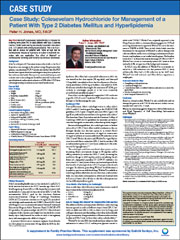
To view the supplement, click the image above.
Topics
• Background
• Current Visit: Exam Findings
• Current Treatment Regimen
• Health History
• Laboratory Results
• Clinical Discussion
• Cardiologist Visit
• Three Months After Visiting the Cardiologist
A supplement to Family Practice News. This supplement was sponsored by Daiichi Sankyo, Inc.
•Topics
•Faculty/Faculty Disclosures

To view the supplement, click the image above.
Topics
• Background
• Current Visit: Exam Findings
• Current Treatment Regimen
• Health History
• Laboratory Results
• Clinical Discussion
• Cardiologist Visit
• Three Months After Visiting the Cardiologist
A supplement to Family Practice News. This supplement was sponsored by Daiichi Sankyo, Inc.
•Topics
•Faculty/Faculty Disclosures

To view the supplement, click the image above.
Topics
• Background
• Current Visit: Exam Findings
• Current Treatment Regimen
• Health History
• Laboratory Results
• Clinical Discussion
• Cardiologist Visit
• Three Months After Visiting the Cardiologist
CASE STUDY: Management Decisions in a Comorbid Patient With Type 2 Diabetes Having Primary Hyperlipidemia
A supplement to Family Practice News. This supplement was sponsored by Daiichi Sankyo, Inc.
•Topics
•Faculty/Faculty Disclosures
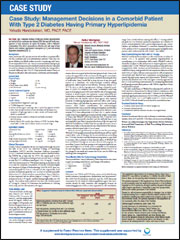
To view the supplement, click the image above.
Topics
• Background
• Current Visit
• Laboratory Results
• Clinical Discussion
• Endocrinologist Consultation
• New Treatment Regimen With Add-On Therapy
• Conclusions
Faculty
Yehuda Handelsman, MD, FACP, FACE
Medical Director, Metabolic Institute of America
Chair and Program Director, 7th World Congress on Insulin Resistance Chair, International Committee for Insulin Resistance
18372 Clark Street, Suite 212
Tarzana, CA 91356
E-mail:[email protected]
Web site:www.TheMetabolicCenter.com
Dr Handelsman is a consultant for Bristol-Myers Squibb Company, Daiichi Sankyo, Inc., GlaxoSmithKline, Medtronic, Merck, Xoma, and Tethys;he has received clinical research grant funding from Takeda, Daiichi Sankyo Inc., GlaxoSmithKline, and Novo Nordisk; and he is on the speakers bureau for AstraZeneca, Bristol-Myers Squibb, Daiichi Sankyo Inc., GlaxoSmithKline, Merck, and Novartis. He also serves on the advisory board for CLINICAL ENDOCRINOLOGY NEWS.
Copyright © 2010 Elsevier Inc.
A supplement to Family Practice News. This supplement was sponsored by Daiichi Sankyo, Inc.
•Topics
•Faculty/Faculty Disclosures

To view the supplement, click the image above.
Topics
• Background
• Current Visit
• Laboratory Results
• Clinical Discussion
• Endocrinologist Consultation
• New Treatment Regimen With Add-On Therapy
• Conclusions
Faculty
Yehuda Handelsman, MD, FACP, FACE
Medical Director, Metabolic Institute of America
Chair and Program Director, 7th World Congress on Insulin Resistance Chair, International Committee for Insulin Resistance
18372 Clark Street, Suite 212
Tarzana, CA 91356
E-mail:[email protected]
Web site:www.TheMetabolicCenter.com
Dr Handelsman is a consultant for Bristol-Myers Squibb Company, Daiichi Sankyo, Inc., GlaxoSmithKline, Medtronic, Merck, Xoma, and Tethys;he has received clinical research grant funding from Takeda, Daiichi Sankyo Inc., GlaxoSmithKline, and Novo Nordisk; and he is on the speakers bureau for AstraZeneca, Bristol-Myers Squibb, Daiichi Sankyo Inc., GlaxoSmithKline, Merck, and Novartis. He also serves on the advisory board for CLINICAL ENDOCRINOLOGY NEWS.
Copyright © 2010 Elsevier Inc.
A supplement to Family Practice News. This supplement was sponsored by Daiichi Sankyo, Inc.
•Topics
•Faculty/Faculty Disclosures

To view the supplement, click the image above.
Topics
• Background
• Current Visit
• Laboratory Results
• Clinical Discussion
• Endocrinologist Consultation
• New Treatment Regimen With Add-On Therapy
• Conclusions
Faculty
Yehuda Handelsman, MD, FACP, FACE
Medical Director, Metabolic Institute of America
Chair and Program Director, 7th World Congress on Insulin Resistance Chair, International Committee for Insulin Resistance
18372 Clark Street, Suite 212
Tarzana, CA 91356
E-mail:[email protected]
Web site:www.TheMetabolicCenter.com
Dr Handelsman is a consultant for Bristol-Myers Squibb Company, Daiichi Sankyo, Inc., GlaxoSmithKline, Medtronic, Merck, Xoma, and Tethys;he has received clinical research grant funding from Takeda, Daiichi Sankyo Inc., GlaxoSmithKline, and Novo Nordisk; and he is on the speakers bureau for AstraZeneca, Bristol-Myers Squibb, Daiichi Sankyo Inc., GlaxoSmithKline, Merck, and Novartis. He also serves on the advisory board for CLINICAL ENDOCRINOLOGY NEWS.
Copyright © 2010 Elsevier Inc.
Once-Daily Cyclobenzaprine Extended-Release: A Simple Alternative to Control Muscle SpasmCLINICAL UPDATE
CLINICAL UPDATE
A supplement to Family Practice News. Funding for this publication was provided by Cephalon, Inc.
•Topic Highlights
•Faculty/Faculty Disclosure
• Cyclobenzaprine Extended-Release (CER) Capsules
• CER for Acute Muscle Spasm: Evaluating the Evidence
• What is the background on the AMRIX clinical study program?
• What were the methodology and patient population for the studies?
• What were the key outcome measures?
• What were the major efficacy findings?
• What was the observed tolerability profile of CER?
• What are the strengths and limitations of these studies?
• What are the important clinical implications of these studies?
Faculty/Faculty Disclosure
Gary E. Ruoff, MD
Clinical Professor of Family Medicine
Michigan State University College of Human Medicine
East Lansing, MI
Dr. Ruoff is on the advisory boards of and has participated in a lecture series for Cephalon, Inc., GlaxoSmithKline, and Takeda Pharmaceuticals North America, Inc. He has conducted research for Abbott Laboratories, Cephalon, Inc., GlaxoSmithKline, Merck & Co., Inc., and Takeda Pharmaceuticals North America, Inc.
Copyright © 2009 Elsevier Inc.
A supplement to Family Practice News. Funding for this publication was provided by Cephalon, Inc.
•Topic Highlights
•Faculty/Faculty Disclosure
• Cyclobenzaprine Extended-Release (CER) Capsules
• CER for Acute Muscle Spasm: Evaluating the Evidence
• What is the background on the AMRIX clinical study program?
• What were the methodology and patient population for the studies?
• What were the key outcome measures?
• What were the major efficacy findings?
• What was the observed tolerability profile of CER?
• What are the strengths and limitations of these studies?
• What are the important clinical implications of these studies?
Faculty/Faculty Disclosure
Gary E. Ruoff, MD
Clinical Professor of Family Medicine
Michigan State University College of Human Medicine
East Lansing, MI
Dr. Ruoff is on the advisory boards of and has participated in a lecture series for Cephalon, Inc., GlaxoSmithKline, and Takeda Pharmaceuticals North America, Inc. He has conducted research for Abbott Laboratories, Cephalon, Inc., GlaxoSmithKline, Merck & Co., Inc., and Takeda Pharmaceuticals North America, Inc.
Copyright © 2009 Elsevier Inc.
A supplement to Family Practice News. Funding for this publication was provided by Cephalon, Inc.
•Topic Highlights
•Faculty/Faculty Disclosure
• Cyclobenzaprine Extended-Release (CER) Capsules
• CER for Acute Muscle Spasm: Evaluating the Evidence
• What is the background on the AMRIX clinical study program?
• What were the methodology and patient population for the studies?
• What were the key outcome measures?
• What were the major efficacy findings?
• What was the observed tolerability profile of CER?
• What are the strengths and limitations of these studies?
• What are the important clinical implications of these studies?
Faculty/Faculty Disclosure
Gary E. Ruoff, MD
Clinical Professor of Family Medicine
Michigan State University College of Human Medicine
East Lansing, MI
Dr. Ruoff is on the advisory boards of and has participated in a lecture series for Cephalon, Inc., GlaxoSmithKline, and Takeda Pharmaceuticals North America, Inc. He has conducted research for Abbott Laboratories, Cephalon, Inc., GlaxoSmithKline, Merck & Co., Inc., and Takeda Pharmaceuticals North America, Inc.
Copyright © 2009 Elsevier Inc.
CLINICAL UPDATE
CLINICAL UPDATE
